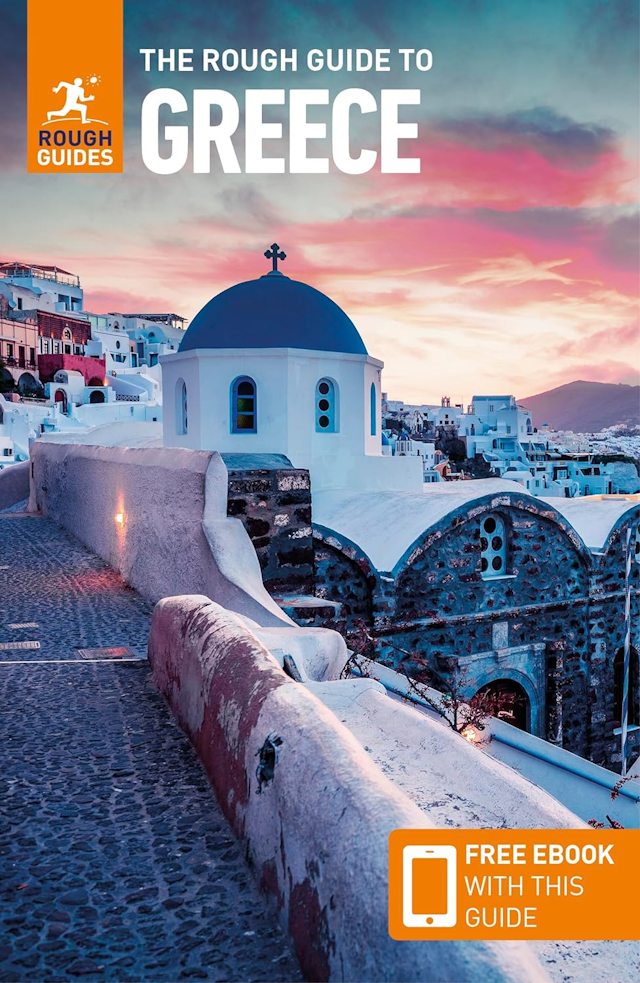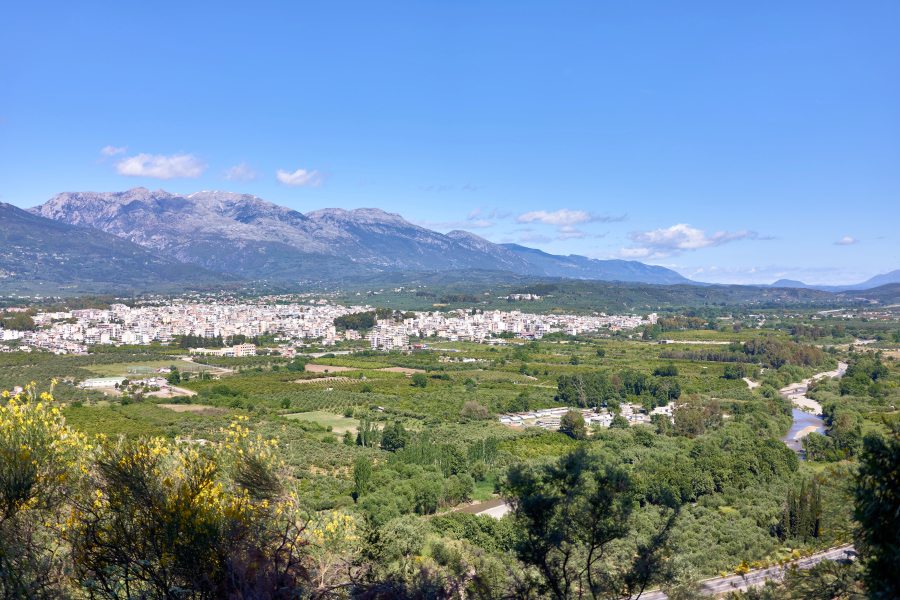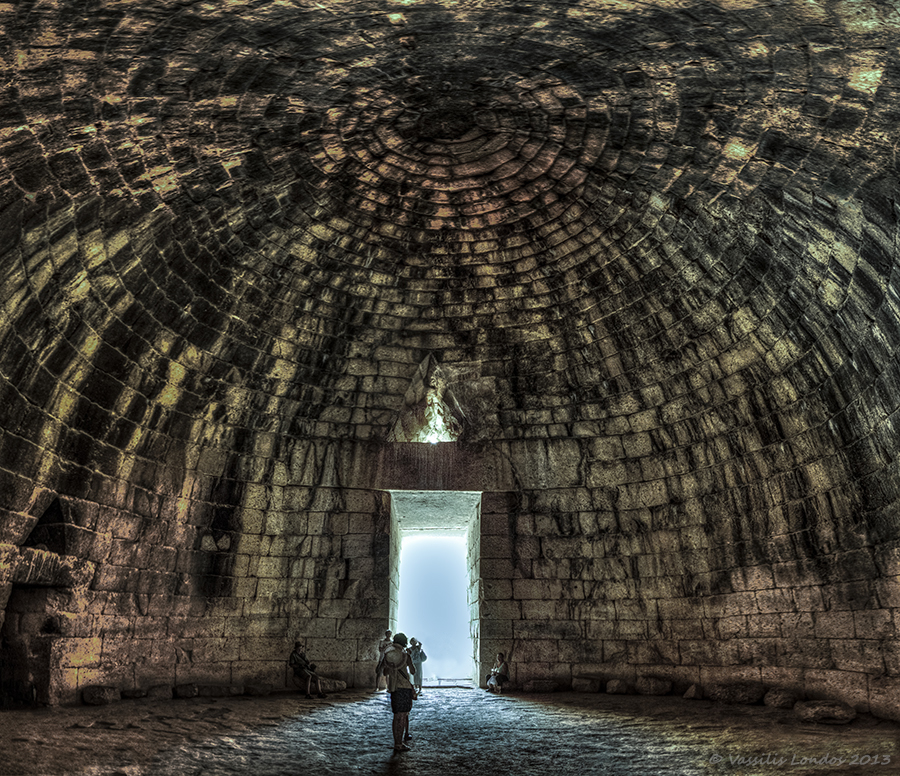- HOME
- Peloponnese
- Corinth
Corinth
Corinth has four aspects to it, which are the Corinth Canal, the modern town of Corinth, nearby Ancient Corinth, and above that Akrokorinthos or Upper Corinth.

Corinth Canal
The Corinth (Korinthos) Canal is one of the great sights of Greece. With luck, you might be there when a ship is being steered between the narrow, sheer walls which stretch away in the distance to link the Gulf of Corinth with the Aegean Sea. The only way to see it - apart from taking a boat through it - is to take the main road from Athens onto the Peloponnese, which crosses over the canal.
From the modern highway you need to exit and get onto the old road that runs parallel to it, and from there you can park and get out to have a lovely view down the canal, an engineering marvel which effectively turned the Peloponnese into a giant island.

Roman Emperor Nero (37-68 AD) first mooted the idea of cutting a canal through the isthmus so that ships could sail from Italy into the Aegean without going all the way round the Peloponnese. He performed the first symbolic excavation in person, using a silver shovel, but the task was never completed. Ships continued to sail up the Gulf of Corinth, unload their cargoes, and have them carried the 3.5 miles (6 km) to a ship waiting on the far side rather than risk losing the cargo on the sometimes stormy circuit around the Peloponnese.
It wasn't until 1893, after a total of 12 years work, that the 75-foot (23-metre) Corinth Canal was finally cut through, enabling boats to sail directly to Piraeus. The canal is still used, though less so these days as it isn't large enough to take the latest super-tankers.
Modern Corinth
A few miles beyond the canal is the modern town of Corinth, which delays few visitors except maybe as a refueling stop or to see its very good Folklore Museum. It's mainly an agricultural service town, but it's interesting to know that it's the centre of the Greek currant industry: the word 'currant' actually derives from the name Corinth.
There are hotels and restaurants if you need to spend the night, but the charms of Nafplion are little more than an hour's drive away, so head there for the evening.
Ancient Corinth
Beyond the modern town, the site of Ancient Corinth is to the south of the main road. Regular buses from modern Corinth also take visitors to and from the site. The site really comes to life as you walk around the well-preserved remains which are dominated by a Temple of Apollo from the 5th century BC. With its massive Doric columns, this is one of the buildings that the Romans left when they redeveloped the city as their provincial capital in 44BC. A small village has grown up around the site, and there are one or two places to stay and to eat.
The city was once home to 300,000 citizens and 460,000 more who were slaves - a total population bigger than today's Denver, Boston, or Washington DC. The smallest buildings are the ones that speak of the history: the remnants of shops, houses, and administrative buildings. The Peirine Fountain was a gift from Herodes Atticus, the wealthy Athenian, patron and friend of the Romans, and the spring beneath it still provides the water supply for the modern town of Corinth.
The Archaeological Museum on the site has a good display of remains found there. Some lovely mosaics, mostly dating from the second-century AD Roman period, are a good indication of the city's wealth at that time. Domestic vases, pottery, and jewellery all give the collection a more human scale.
Upper Corinth
Overlooking the lower city from the hilltop 2.5 miles (4 km) away was Akrokorinthos, or Upper Corinth. To get here you'll need a car or take a taxi from Corinth, and though it's a bit steep you can hike it or bike it too. Akrokorinthos's walls and spectacular views are the chief reasons to visit.
When you see the position the city commands, you realise its strategic importance and why it was refortified by every subsequent wave of invaders, including the Venetians, the Franks, and the Turks. The walls run for 1.25 miles (2 km) around the 60-acre (24-hectare) site, where you can find the remains of chapels, mosques, houses, fortifications, and the still-working Turkish Fountain of Hatzi Mustafa.
Latest Posts
-
Explore Vikos Gorge: Hiking, Rafting, and Food in Zagori
One of the most impressive canyons in Europe and one of Greece’s favorite mountain destinations, Vikos Gorge invites hikers and food lovers alike. -
Lefkada: The First Ancient Theater of the Ionian Islands Comes to Light
The first ancient theater ever discovered in the Ionian Islands is located in the heart of the ancient city of Lefkada, established before the end of the 7th century BC. -
5 Epic Island Hikes in Greece for Spring Explorers
This spring, five majestic peaks across Greece’s islands invite us to lace up our boots and discover a wilder side of island life. -
Greek Ferry Services to Halt on May 1 Due to Labor Strike
Ferries in Greece will remain docked for 24 hours on Thursday, May 1, as the Pan-Hellenic Seamen’s Federation (PNO) joins Labor Day mobilizations announced by the General Confederation of Greek Labor… -
Sifnos: Greece’s Hidden Culinary Star on the Rise
Sifnos, a Cycladic island, is gaining fame for its rich culinary heritage, especially the beloved melopita honey-cheese tart. -
Easter in the Mystical Castle of Monemvasia
In the castle town of Monemvasia, with its dramatic medieval backdrop and sea views, Easter is a deeply spiritual and atmospheric experience. -
Easter in Leonidio: A Tapestry of Light, Culture and Cliffs
In Leonidio, Easter comes alive with handmade hot air balloons in the sky and lanterns made from bitter oranges in the streets. -
The Lesser-Known Traditions of Greek Easter
Step off the beaten path this spring and discover the enchanting — and often surprising — Easter traditions found across Greece. -
April 9 Strike in Greece to Impact Public Transport, Ferries and Air Travel
Transportation and travel across Greece will face disruptions on Wednesday, April 9, as public transport, ferry and aviation workers join a nationwide strike called by Greek labor unions. -
Ancient Theater of Lefkada Brought Fully to Light Following Systematic Excavation
The Greek Culture Ministry has announced that the first ancient theater ever identified in the Ionian Islands has recently been brought fully to light on Lefkada, revealing an impressive monument that…




























